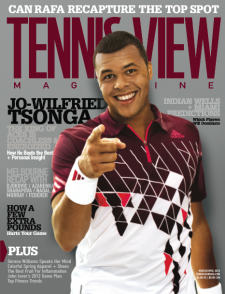Don't miss any stories → Follow Tennis View
FollowThe Quirky Ukrainian
Discover one of the Alexandr Dolgopolov’s deceptive weapons, his serve
Over the years, we have seen many different service motions and routines. Pete Sampras lifted his left foot before he served, John McEnroe had an extra-wide stance and tilted heavily forward before starting the service motion and Andy Roddick, with his feet nearly touching, cocks his dominant arm and abbreviates the explosive motion. Then along came Alexandr Dolgopolov, the skinny 5-foot- 11 Ukrainian has one of the most unorthodox service motions of them all. But despite the varying styles of Sampras, McEnroe, Roddick and Dolgopolov, the serves have similarities – they all have sound mechanics and are very effective.
As the Ukrainian’s serve is dissected, it’s discovered that his oddities are his greatest weapon.
QUIRKY MOTION
Dolgopolov has all the basic elements of a great serve: knee bend, shoulder rotation, elevation into the serve and a smooth follow-through. Traditionally, his motion would be considered too fast, but because he’s comfortable with the tempo, the pace is fine. “I had a normal technique growing up,” says Dolgopolov. “I just started jumping out hitting the ball faster. I think it’s pretty effective because my opponent can’t really read the serve.” He adds that no one taught him this serve technique. He acquired it himself.
Much like a baseball pitcher with an awkward delivery, Dolgopolov’s motion confuses and distracts the opposition. “Dolgopolov has great physical talent – live arm, very fast, explosive, screws his opponent up with the violence of his attack,” says coach and former top ATP player Allen Fox.
HARD TO READ IS HARD TO BEAT
Touring pros say Dolgopolov’s unique style makes returning serves difficult. His toss, incidentally, is also out of the ordinary because it is very low. The ball toss is just high enough to get a good knee bend and elevate to the ball at precisely the moment it reaches its apex. Most servers, on the contrary, allow the ball to drop slightly after it reaches the apex before making contact. Andy Murray says Dolgopolov is tricky. “He’s just unorthodox, very different to how most guys play. Obviously it’s tough to get into a rhythm. But he’s also a very, very good player, definitely not someone to be underestimated.”
Dolgopolov comes from a family of athletes. His mother, Elena, was a gymnast who earned a gold and silver medal at the European Championships and his father, Oleksandr, was a former ATP pro and coached Alexandr from a young age until 2008. Alex has a good pedigree for sport and aspires to be World No. 1. Murray says to watch out for Dolgopolov, “With his game style, he’s going to give a lot of guys problems in the future.”
Pros and Cons
Pro: Simplicity
Even though Dolgopolov’s serve appears erratic, it is very simple at its core. There isn’t a lot of unnecessary motion, and the low toss actually works in his favor when trying to reduce the affects of sun glare and wind.
Pro: Originality
Not one serve on the pro circuit looks the same as the other, which makes watching tennis very interesting, and what works for one player may not work for another. When you analyze Dolgopolov’s serve, recognize that it is acceptable – and sometimes advantageous – to be different as long as it works for you.
Con: Inconsistency
A quick serve motion doesn’t leave room for error. If the rhythm is off, the serve is unreliable. “He might be a little bit inconsistent from time to time,” says Murray, “but when his game’s on, I’m sure, he’ll get deep into Grand Slams and the big tournaments just because of how tricky his game is.
”Should You Copy Dog’s Serve?
When trying to imitate a players’ serve, notice the key elements within the serve of each player: knee bend, shoulder rotation and elevation. Then take these key
elements and add your own personality, twists and quirks to make the serve your own.
Serve Elements
Knee Bend
Dolgopolov begins with his feet relatively close together, not the typical shoulder width apart, allowing him to execute a deep knee bend as all great servers have.
Shoulder Rotation
During the toss and backswing, Dolgopolov rotates his shoulders allowing for a “corking” of the body and loads of stored energy and power. From this point, his motion is exceptionally quick, so the energy that is stored is released fast up and into the ball.
Elevation into the Serve
With his deep knee bend and good shoulder rotation he gets great elevation up to the ball and into the court. At full extension, he gets great height as he makes contact with the ball. When he lands onto the court, he is on his left leg and very balanced.
On a side note: most recreational players do not elevate and land on the correct foot. Most right-handed recreational players serve
and transfer their weight onto their right foot, meaning they are not elevating up and into the ball but only more forward and into the court.
This article is from the March / April 2012 issue |
|

|
SOLD OUT Subscribe now and you'll never miss an issue!
|











